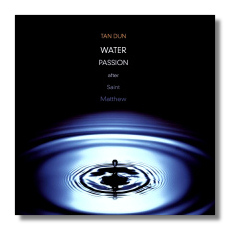
The Internet's Premier Classical Music Source
Related Links
- Latest Reviews
- More Reviews
-
By Composer
-
Collections
DVD & Blu-ray
Books
Concert Reviews
Articles/Interviews
Software
Audio
Search Amazon
Recommended Links
Site News
 CD Review
CD Review
Tan Dun

Water Passion after Saint Matthew
Elizabeth Keusch, soprano
Stephen Bryant, bass
Mark O'Connor, violin
Maya Beiser, cello
David Cossin, Martin Homann & Adam Weisman, percussion
RIAS-Kammerchor, Berlin/Tan Dun
Sony Classical S2K89927 DDD 2CDs: 56:58, 35:09
The 250th anniversary of Bach's death was marked by the appearance of newly commissioned Passion settings by Osvaldo Golijov, Wolfgang Rihm, and Tan Dun. I'm not sure what Bach would have made of the latter's eclectic, Asian-influenced Water Passion after Saint Matthew. For his part, given his upbringing and musical education in Communist China, Tan Dun didn't hear Bach's music until the late 1970s, when he was twenty.
As the title suggests, water plays an important visual and musical role in this work. Seventeen large transparent bowls of water, dramatically lit from below, form a cross on the stage. The water is needed to play some of the percussion instruments; Tan Dun has scored the Passion for what he calls a "Water-Instruments-Orchestra." For the composer, water is "a metaphor for the unity of the eternal and the external, as well as a symbol of baptism, renewal, recreation, and resurrection." The sound of water appropriately begins and closes the Passion.
Tan Dun asks the violinist and the cellist to emulate the sound of the Chinese, Mongolian, and other Asian instruments. The chorus and vocalists engage in overtone singing (in the manner of Tuvan throat-singing), styles derived from the Peking Opera, and chanting. One might ask what this all has to do with the Passion of Jesus Christ, but Tan Dun convincingly, movingly, and powerfully retells the familiar story, imposing his own unique, but devout imprint on it. The not inappropriate sensation of ritual is intensified – what was the Last Supper if not the creation of a now two-thousand-year-old ritual? – and the ancient, unfamiliar styles reinforce the universality and timelessness of the Passion. The Western world does not hold a monopoly on Christianity, after all. Much of the Water Passion is beautiful and spare, as one would expect, given the work's antecedents. On other hand, the crowd scenes, what Bach might have called the turbae, are made shockingly violent in the Water Passion, and some of the solo singing will seem harsh to many Western ears. (The Water Passion will show that Yoko Ono's ululations around the time of the Live Peace album were not just a personal fluke.) Tan Dun pulls no punches in the Water Passion; nor is this a tiresome exercise in Multiculturalism 101. Instead, this is an innovative, humanistic concept expertly realized, with no pandering and no self-indulgence. This recording was made in the presence of an audience, and their warm response, at the work's conclusion, is sincere and well-deserved. The Water Passion bids fair to be one of the best new works of 2000.
This recording was made in Stuttgart under the direction of the composer. Of course the work's visual component cannot be appreciated here, but the powerful theatricality of the Water Passion shines through. The only drawback is the German-accented English of the chorus. (Tan Dun wrote the Water Passion in English.) Sony's recording preserves the charged atmosphere of even the quietest moments, and the percussion and choral climaxes are captured with frightening accuracy.
This is a "don't miss" release.
Copyright © 2002, Raymond Tuttle




















